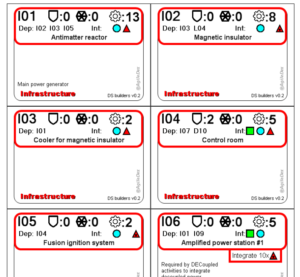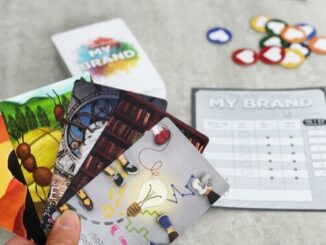
Corrado De Sanctis also published an article about DSBuilders game last month.
The game is a work in progress. This article deatils the version that you can see at Corrado’s workshop at AgileTour London 2020 in October.
As both these article refer specifically to terms related to Agile methodology, you may find this terminology reference in the Ludogopedia useful.
In this article I want to tell you the story about how DSbuilders evolved from the initial version with particular reference to card design. I think this is helpful to understand how creating a game can be complex like writing a book.
I started working on this game in March 2019, after a couple of PI Planning sessions with a SAFe ARTs (Scaled Agile Framework – Agile Release Train). During those situations I noticed teams were struggling in collaborating and we were not able to engage people in the right way. SAFe is very clear about the objective of PI Planning and defines a very precise agenda, but there is no clue on how to make people work. The reason is because this is based more on the experience and ability of the team members rather than the coaches’ experience. What could we do to enhance this ability? A game obviously.
So I had the idea to create a situation where teams have a complex interlocked backlog of stories to let people test the collaboration model quickly and safely. Ideally this should be a serious game because we should have some fun to make this really effective (otherwise it is just like normal work) and we should create some realistic, challenging but feasible scenarios where people can understand what they are going to do without worrying about building it.
So we came up with the idea to use a Star Wars like scenario.
The first draft of the backlog (i.e. the set of all components to build) took around two months, in the spare time of my working days, and gained great momentum with the idea of arranging a meetup on team collaboration.
I was so focused on the backlog, but actually I had no idea on how to build 100+ cards. So I started to learn about standards (cards are poker sized so you can use standard products and services), tools and techniques.
Keep in mind that the game now has four different type of cards (Components, Initiatives, Events and Roles, 135 cards), but at the beginning I focused on the Components cards.

Here is the first version of the cards: apart from the basic graphic, the logic of the connectors was completely different (here you can see three of them in the bottom right corner: “MOD”, “LIV”, “DEC”). However most of the information were already there and even with this basic format we were able to arrange the first sessions and in particular Play14 unconference where we managed two different sessions. Here we had a lot of gamers and I collected a lot of feedback that brought about the second version.

This card on the right in particular is just from the second session of Play14 where I introduced the new version of the connectors literally drawing them on the card. Good or not, this prototype created overnight was good enough to be successfully tested.
Next time you are asked for an example of MVP you can mention version 1 of DSbuilders!
With all the feedback collected, I approached version 2 and we tried to experiment with colours. Even if the main graphic goal was to concentrate most of the information in the top of the cards to optimise the distribution of the cards on the mission board.

The colour experiment was not really successful, also because I think that colour shouldn’t convey any information, so that ideally, cards could be printed also in greyscale.
Here I added the second evolution of the connectors, directly based on the feedback collected from players until that moment (100+ people have been already involved).
Connectors looked like the weakest feature of the game: apparently players were not able to understand how these were working. In the image on the right you can see in the card I06 how the “connector producer” card is differentiated from the other components cards. Also connectors switched to four types.

On the right you can see the true version 2 of the cards. The design of the card now looks more linear: I created specific icons for Defence, Supremacy and Complexity and I integrate the new connector icons. As you can see cards are still greyscale.
In this version I also reviewed dependencies: a few mistakes were fixed and some more logical connectors have been created. Finally I introduced at a later stage the third improvement on the connectors: tokens.
This version has been developed for a series of workshops between October and December, planned as follow ups of the successful September sessions. And obviously I collected more feedback, but also I started thinking that the game was almost ready to go public.
Finally came the new version of the cards that have completely redesigned with the metaphor of the “blue print”.

As you can see here the graphic review was the main improvement, even if I added few more ideas to improve collaboration and make this more realistic (for example the adoption of the alien alphabet). Now the design looks more professional and with the 3D boxes with shadows gives an idea of a working desk with all information randomly placed over the project sheet.
Is this the final version? Let’s start collecting feedback and we will see, for sure I have in mind some expansions.
Are you ready to conquer the galaxy?
- Applying Agile Practices to Create an Agile Serious Game - 24th September 2021
- Pizza KATA IIRetrospect is a Mindset and Not an Action - 8th July 2021
- Pizza KATA or “Change is a Mindset and not an Action” - 14th May 2021





A really interesting narrative, Corrado. I’ve been jumping through some similar hoops with the development of a deck of cards for learning design inspiration that I’m working on at the moment. You nicely show the value of prototyping, testing and iteration, and also of not getting too hung up on aesthetics in early prototyping. I look forward to hearing about their later stages of life and use.
I (Sarah) have played with these cards Terry, and I can tell you that Corrado is very assiduous with his feedback and iteration processes. I think they will be widely adopted as a valuable learning tool.